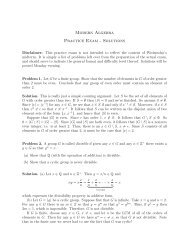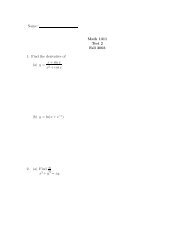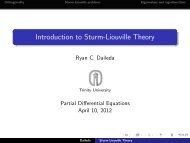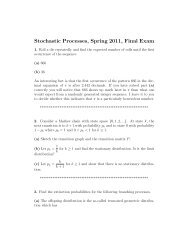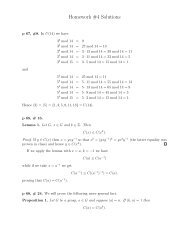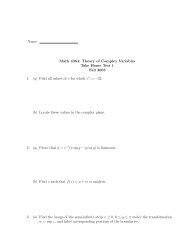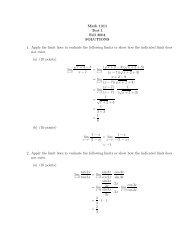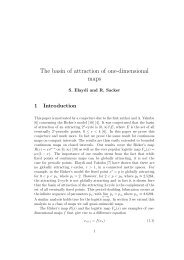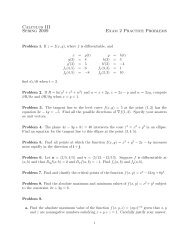Real Analysis Fall 2004 Take Home Test 1 SOLUTIONS 1. Use the ...
Real Analysis Fall 2004 Take Home Test 1 SOLUTIONS 1. Use the ...
Real Analysis Fall 2004 Take Home Test 1 SOLUTIONS 1. Use the ...
Create successful ePaper yourself
Turn your PDF publications into a flip-book with our unique Google optimized e-Paper software.
<strong>Real</strong> <strong>Analysis</strong><br />
<strong>Fall</strong> <strong>2004</strong><br />
<strong>Take</strong> <strong>Home</strong> <strong>Test</strong> 1<br />
<strong>SOLUTIONS</strong><br />
<strong>1.</strong> <strong>Use</strong> <strong>the</strong> definition of a limit to show that<br />
(a) lim<br />
n→∞<br />
sin n<br />
n = 0<br />
(b)<br />
Proof. Let ε > 0 be given. Define N > 1 , where N is a positive integer. Then for<br />
∣ ε n > N,<br />
sin n ∣∣∣<br />
∣ n<br />
− 0 ≤ 1 n < 1 sin n<br />
< ε. Hence lim<br />
N n→∞ n = 0 .<br />
1<br />
lim<br />
n→3 + x − 3 = ∞<br />
Proof. Let A > 0 be given. Define δ = 1 1<br />
. Then for x−3 < δ, f(x) =<br />
A x − 3 > 1 δ = A.<br />
1<br />
Hence lim<br />
x→3 + x − 3 = ∞.<br />
2. (a) Let {x n } be a bounded sequence of real numbers and {x kn } be a monotone subsequence.<br />
Prove that {x kn } converges to a limit.<br />
Proof. By Bolzano-Weierstrass Theorem, <strong>the</strong> bounded subsequence {y n } = {x kn }<br />
has a convergent subsequence {y ln } which converges to x 0 . Now ei<strong>the</strong>r {x kn } is<br />
nondecreasing or nonincreasing. Without loss of generality, assume that {y n } is<br />
monotonically nondecreasing. Given ε > 0, <strong>the</strong>re exists N such that n > N implies<br />
x 0 − ε < y ln < x 0 + ε. In particular, x 0 − ε < y lN+1 < x 0 + ε. For n > l N+1 we have<br />
x 0 − ε < y lN+1 < y n < x 0 + ε. Thus lim y n = lim x kn = x 0 .<br />
n→∞ n→∞<br />
1<br />
(b) If lim x n = L = ∅, prove that lim = 1<br />
n→∞ n→∞ x n L<br />
Proof. Let ε 1 = |L|<br />
2 . Then <strong>the</strong>re exists N 1 > 0 such that for n > N 1 , |x n − L| < |L|<br />
2 .<br />
Consequently, for n > N 1 ,<br />
|x n | = |x n − L + L| ≥ |L| − |x n − L| > |L| − |L|<br />
2 = |L|<br />
2 .
For any given ε > 0 <strong>the</strong>re exists N 2 > 0 such that for n > N 2 , |x n − L| < 2ε<br />
L . 2<br />
Let N = max{N 1 , N 2 }. Then for n > N,<br />
1<br />
Thus lim<br />
n→∞ x n<br />
= L.<br />
1<br />
∣ − 1 x n L∣ = |x n − L|<br />
|x n ||L|<br />
≤ |x n − L|<br />
L 2 / 2<br />
< 2ε/L2<br />
L 2 / 2<br />
= ε.<br />
1<br />
3. Let x n+1 = , x 1 > 0. Prove that <strong>the</strong> sequence {x n } converges and <strong>the</strong>n compute<br />
3 + x n<br />
<strong>the</strong> limit of <strong>the</strong> sequence.<br />
1<br />
< 1 3 + x n 3<br />
= 3<br />
10 for all n ≥ <strong>1.</strong> Hence 3 10 < x n < 1 3<br />
First Proof (My Preference). Since x 1 > 0, x n+1 =<br />
x n+1 = 1<br />
3 + x n<br />
< 1<br />
3 + 1 3<br />
1<br />
(b) If lim x n = L exists, <strong>the</strong>n L = lim x n+1 = lim =<br />
n→∞ n→∞ n→∞ 3 + x n<br />
Thus<br />
L = −3 + √ 13<br />
.<br />
2<br />
(a) If x 1 > L, <strong>the</strong>n x 2 =<br />
1<br />
3 + L<br />
for all n ≥ <strong>1.</strong> Moreover,<br />
for all n > <strong>1.</strong><br />
1<br />
lim (3 + x n) = 1<br />
3 + L<br />
n→∞<br />
= L. (1)<br />
L 2 + 3L − 1 = 0. (2)<br />
1<br />
< 1<br />
3 + x 1 3 + L = L from (1). More generally, if x 2n−1 > L,<br />
1<br />
<strong>the</strong>n x 2n = < 1<br />
3 + x 2n−1 3 + L = L. On <strong>the</strong> o<strong>the</strong>r hand, if x 1 < L, <strong>the</strong>n x 2n−1 < L<br />
and x 2n > L. Without loss of generality, assume x 1 > L. Define <strong>the</strong> sequence {s n }<br />
as s n = |x n − L|. Then claim that s n+1 < s n for all n ≥ <strong>1.</strong> If not, <strong>the</strong>n s n+1<br />
≥ <strong>1.</strong><br />
s n<br />
Assume n = 2k. Then<br />
s 2k+1<br />
s 2k<br />
= x 2k+1 − L<br />
L − x 2k<br />
=<br />
1<br />
3+x 2k<br />
− L<br />
≥ 1<br />
L − x 2k<br />
1 − 3L − Lx 2k ≥ 3L − 3x 2k + Lx 2k − x 2 2k<br />
(x 2 2k − 2Lx 2k + L 2 ) − L 2 − 6L + 3x 2k + 1 ≥ 0<br />
(x 2k − L) 2 − 1 − 3L + 3x 2k + 1 ≥ 0 (using (2))<br />
(x 2k − L)[x 2k − L + 3] ≥ 0.
Since x 2k − L < 0, x 2k − L + 3 ≤ 0 or x 2k ≤ L − 3 < 0, a contradiction.<br />
A similar conclusion is obtained for n = 2k − <strong>1.</strong><br />
Since s n is bounded and monotonically decreasing, lim<br />
s n = α. Thus lim s 2n = α =<br />
n→∞ n→∞<br />
lim s 2n+<strong>1.</strong> For <strong>the</strong> case x 1 > L, x 2n+1 > L and x 2n < L and consequently<br />
n→∞<br />
(i) s 2n = L − x 2n → α ⇒ x 2n → L − α as n → ∞,<br />
(ii) s 2n+1 = x 2n+1 − L → α ⇒ x 2n+1 → L + α as n → ∞.<br />
Now<br />
lim x 1<br />
2n+1 = lim<br />
n→∞ n→∞<br />
1<br />
3 + L − α<br />
⇒ L + α =<br />
3 + x 2n<br />
L 2 + 3L − 1 + 3α + αL − α 2 − αL = 0<br />
α(3 − α) = 0 ⇒ α = 0 or α = 3.<br />
If α = 3, L − α < 0 and L + α > 1 3 , a contradiction.<br />
lim x n = L.<br />
n→∞<br />
Hence α = 0 and thus<br />
Second Proof. Let f(x) =<br />
1<br />
(3 + x) 2 ≤ 1 3<br />
for all x > 0. Now1<br />
1<br />
3 + x . Then f ′ (x) =<br />
−1<br />
(3 + x) 2 . Since x > 0, |f ′ (x)| =<br />
|x 2 − L|<br />
|x 1 − L| = |f(x 1) − L|<br />
|x 1 − L|<br />
= |f ′ (ξ 1 )| ≤ 1 3<br />
by <strong>the</strong> Mean Value Theorem, where ξ 1 is between x 1 and L. |x 2 −L| ≤ 1 3 |x 1−L|. Similarly,<br />
|x 3 − L|<br />
|x 2 − L| = |f(x 2) − L|<br />
= |f ′ (ξ 2 )| ≤ 1 |x 2 − L|<br />
3 ,<br />
ξ 2 between x 2 and L. |x 3 − L| ≤ 1 3 |x 2 − L| ≤<br />
( 1<br />
3<br />
) 2<br />
|x 1 − L|. By induction, |x n − L| ≤<br />
( 1<br />
3<br />
) n−1<br />
|x 1 − L| → 0 as n → ∞. Thus lim<br />
n→∞<br />
x n = L.<br />
4. Prove that <strong>the</strong> function f(x) = 1 is continuous for all real numbers x ≠ 0.<br />
x2 1 L is defined as <strong>the</strong> fixed point of f, i.e., f(L) = L = 1<br />
3 + L ⇒ L2 + 3L − 1 = 0 ⇒ L = −3 + √ 13<br />
2
Method <strong>1.</strong> Let ε > 0 be given. Let x 0 ∈ R\{0}. Put δ = |x 0|<br />
2 . Then if |x − x 0| < δ = |x 0|<br />
2 ,<br />
<strong>the</strong>n |x 0|<br />
2 < x < 3|x 0|<br />
2 . Let δ 2 = ε<br />
10 |x 0|x 2 0 . For δ = min(δ 1, δ 2 ), if |x − x 0 | < δ, <strong>the</strong>n<br />
1<br />
∣x − 1 2 x 2 ∣ = |x2 0 − x2 |<br />
0 x 2 0x 2<br />
= |x − x 0||x + x 0 |<br />
x 2 0x 2<br />
< |x − x 0| 5 |x 2 0|<br />
x 2 x 2 0<br />
0<br />
4<br />
≤ |x − x 0| · 10<br />
|x 0 |x 2 0<br />
= ε<br />
Method 2. Consider <strong>the</strong> function g(x) = x 2 . Given ε > 0, let δ 1 = |x 0|<br />
2 . Then |x 0|<br />
2 < x <<br />
3|x 0 |<br />
for all |x−x 0 | < δ 1 . Let δ 2 =<br />
2ε<br />
2<br />
5|x 0 | . Then for δ = min(δ 1, δ 2 ), and x ∈ (x 0 −δ, x 0 +δ),<br />
we have<br />
|x 2 − x 2 0 | = |x − x 0||x + x 0 |<br />
< |x − x 0 | 5|x 0|<br />
2<br />
≤ ε.<br />
Then use a <strong>the</strong>orem about <strong>the</strong> reciprocal of a continuous function is continuous.<br />
5. Suppose that f is continuous on [a, b], one-to-one (if x 1 ≠ x 2 , <strong>the</strong>n f(x 1 ) ≠ f(x 2 )), and<br />
f(a) < f(b). Prove that f is monotonically increasing (strictly) on [a, b].<br />
Proof. Suppose that f is not monotonically increasing on [a, b].<br />
b<br />
a<br />
a<br />
b
Then <strong>the</strong>re exists x 1 , x 2 ∈ [a, b] with x 1 < x 2 but f(x 1 ) > f(x 2 ). We have two cases to<br />
consider:<br />
Case (i): If f(a) < f(x 1 ), <strong>the</strong>n f(a) lies between f(x 1 ) and f(x 2 ). Hence by <strong>the</strong> Intermediate<br />
Value Theorem, <strong>the</strong>re exists c between x 1 and x 2 with f(c) = f(a), a<br />
contradiction to <strong>the</strong> assumption that f is one-to-one.<br />
Case (ii): If f(a) > f(x 1 ), <strong>the</strong>n since f(a) < f(b), <strong>the</strong> value f(a) lies between f(x 1 ) and<br />
f(b). Again, by <strong>the</strong> Intermediate Value Theorem, <strong>the</strong>re exists d between x 1 and b<br />
with f(d) = f(a), a contradiction. Hence f is increasing.<br />
6. Suppose that S 1 , S 2 , . . . , S n are sets in R 1 and that S = S 1 ∩ S 2 ∩ · · · ∩ S n , S ≠ ∅. Let<br />
B i = sup S i , b i = inf S i , 1 ≤ i ≤ n. Find a formula relating sup S and inf S in terms of<br />
<strong>the</strong> {b i } and {B i }.<br />
Proof. S = ∩ n i=1 S i. Claim that sup S = min{B i , 1 ≤ i ≤ n}. Let B r = min{B i : 1 ≤ i ≤<br />
n}. If x ∈ S, <strong>the</strong>n x ∈ S r , and hence x ≤ B r . Thus sup S ≤ B r . On <strong>the</strong> o<strong>the</strong>r hand,<br />
sup S ≥ x ∈ S r and by <strong>the</strong> definition of B r , sup S ≥ B r . Hence sup S = B r .<br />
One may show in a similar fashion that inf S = max{b i |1 ≤ i ≤ n}.<br />
7. Suppose that lim f(x) = ∞ and lim g(x) = a. Suppose that for some positive number<br />
x→a x→−∞<br />
M, we have g(x) ≠ a for x < −M. Prove that lim f(g(x)) = ∞.<br />
x→−∞<br />
Proof. Since lim f(x) = ∞, for any A > 0, <strong>the</strong>re exists δ > 0 such that |x − a| < δ ⇒<br />
x→a<br />
|f(x)| > A. For this δ <strong>the</strong>re exists ˜M > 0 such that x < −˜M ⇒ |g(x) − a| < δ. Let<br />
K = max{˜M, M}. Then for x < −K, |g(x) − a| < δ and thus |f(g(x))| > A. Hence<br />
lim<br />
x→−∞<br />
f(g(x)) = ∞.<br />
8. If f(x) is continuous on [a, b], if a < c < d < b, and M = f(c) + f(d), prove <strong>the</strong>re exists a<br />
number ξ between a and b such that M = 2f(ξ).<br />
Proof. Let M = f(c)+f(d). If f(c) ≤ f(d), <strong>the</strong>n M 2<br />
and M f(c) + f(d) f(c) + f(c)<br />
= ≥<br />
2 2<br />
2<br />
=<br />
f(c) + f(d)<br />
2<br />
≤<br />
f(d) + f(d)<br />
2<br />
= f(d),<br />
= f(c). By <strong>the</strong> Intermediate Value Theorem (since<br />
f(c) ≤ M ≤ f(d)), <strong>the</strong>re exists ξ between c and d (hence between a and b) such that<br />
2<br />
f(ξ) = M . Thus M = 2f(ξ).<br />
2
9. Suppose that f(x) and g(x) are functions defined for x > 0, lim g(x) exists and is finite,<br />
x→0 +<br />
and |f(b) − f(a)| ≤ |g(b) − g(a)| for all positive real number a and b. Prove that lim f(x)<br />
x→0 +<br />
exists and is finite.<br />
Proof. Suppose that lim g(x) = L and |f(b) − f(a)| ≤ |g(b) − g(a)|. If lim f(x) does<br />
x→0 + x→0 +<br />
not exist, <strong>the</strong>re exists ε > 0 and two sequences x n > 0, z n > 0 such that lim x n = 0,<br />
n→∞<br />
lim z n = 0 and for all n |f(x n ) − f(z n )| ≥ ε. For this ε > 0 <strong>the</strong>re exists δ > 0 such that<br />
n→∞<br />
0 < x < δ ⇒ |g(x) − L| < ε 2 . Now for 0 < ̂x 1, ̂x 2 < δ,<br />
|g( ̂x 1 ) − g( ̂x 2 )| = |g( ̂x 1 ) − L − g( ̂x 2 ) + L|<br />
≤ |g( ̂x 1 ) − L| + |g( ̂x 2 ) − L|<br />
< ε 2 + ε 2<br />
= ε.<br />
For this δ <strong>the</strong>re exists N such that n > N, 0 < x n , z n < δ. Hence for n > N |f(x n ) −<br />
f(z n )| ≤ |g(x n ) − g(z n )| < ε, a contradiction. Thus lim f(x) exists.<br />
x→0+<br />
2 + 2 1 2 + 2 1 3 + · · · + 2 1 n<br />
10. Evaluate lim<br />
.<br />
n→∞ n<br />
(You need not give a proof but you should show some work or justification. Quote a<br />
<strong>the</strong>orem or what have you. Calculator results or graphical analysis are not acceptable.)<br />
Proof. Let s n = 2 + 2 1 2 + · · · + 2 1 n<br />
. Then 1 < n2 1 n<br />
n<br />
n < s n < n · 2 = 2. Notice lim<br />
n<br />
2 1 n = <strong>1.</strong><br />
n→∞<br />
Thus s n is bounded. Moreover, we claim that s n+1 < s n . Suppose <strong>the</strong> contrary, that is<br />
s n+1 ≥ s n . Then<br />
Hence<br />
or<br />
(2 + 2 1 2 + · · · + 2 1 n + 2 1<br />
n+1 )<br />
n + 1<br />
≥ (2 + 2 1 2 + · · · + 2 1 n )<br />
.<br />
n<br />
n(2 + 2 1 2 + · · · + 2<br />
1<br />
n ) + n2<br />
1<br />
n+1 ≥ n(2 + 2<br />
1<br />
2 + · · · + 2<br />
1<br />
n ) + 2 + 2<br />
1<br />
2 + · · · + 2<br />
1<br />
n<br />
which is a contradiction.<br />
n2 1<br />
n+1 ≥ 2 + 2<br />
1<br />
2 + · · · + 2<br />
1<br />
n ≥ n2<br />
1<br />
n , n > 1<br />
Hence {s n } is a monotone bounded sequence and thus is converges by <strong>the</strong> Bolzano-<br />
Weierstrass Theorem. Moveover, lim<br />
n→∞<br />
s n = <strong>1.</strong>



